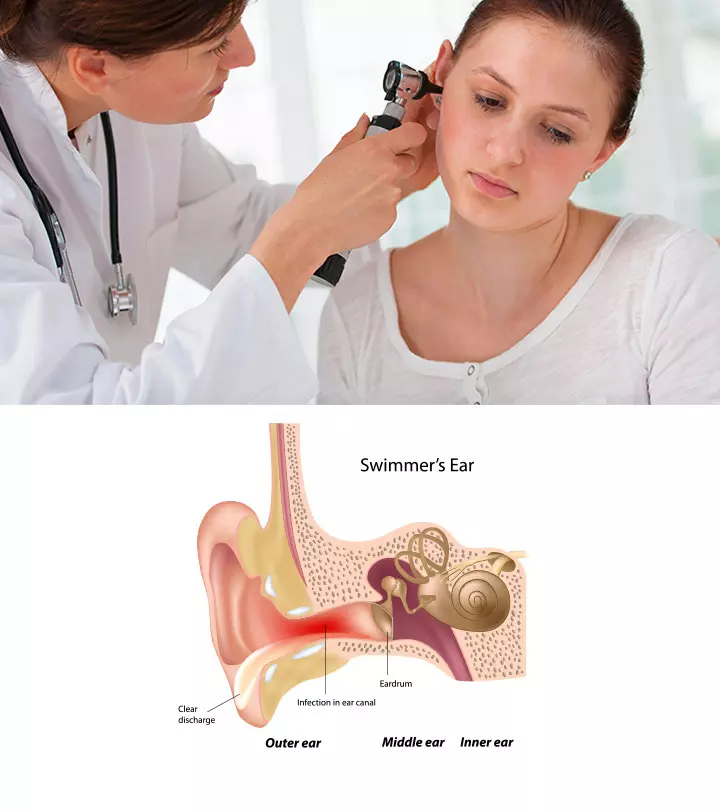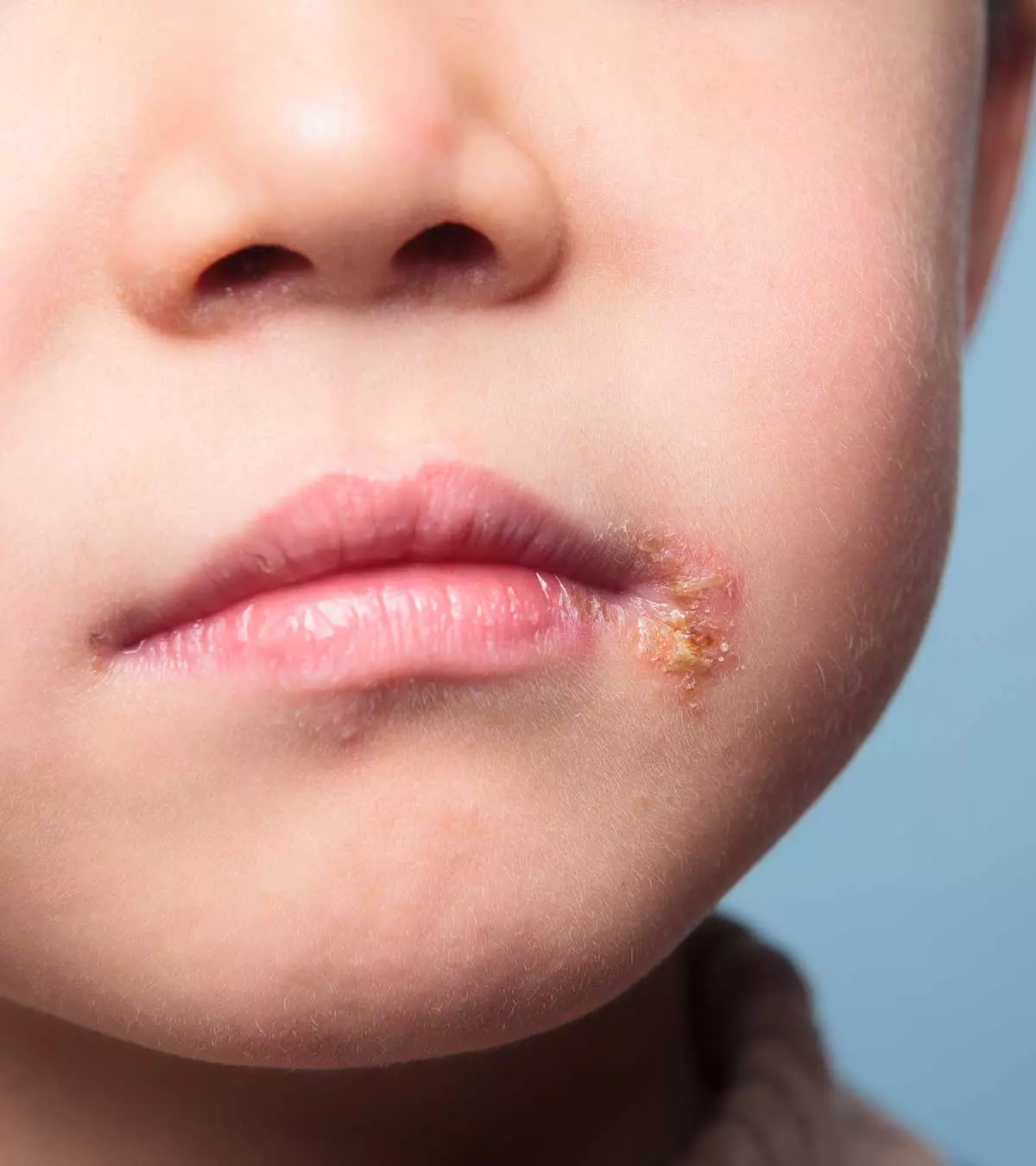
Image: MomJunction Design Team
Feeling fullness in the ear and earache are the common symptoms of ear infection in teens. It is called acute otitis media or otitis media when the middle ear, air-filled space behind the eardrum is infected. The middle ear contains bones that aid in hearing. Younger children are more vulnerable to middle ear infections than teenagers since their short and horizontal eustachian tubes connect to the throat (1). Pain relievers are often prescribed since most teens may have severe ear pain. Read on to know the causes, symptoms, diagnosis, and treatment of ear infections in teens and ways to prevent them.

Key Pointers
- Teenagers may experience ear pain and a feeling of fullness in their ears due to an ear infection, commonly known as acute otitis media or otitis media.
- Causes of teenage ear infections include viruses, bacteria, and fungi.
- Consult a doctor in case of severe ear discomfort, a fever, hearing loss, or symptoms that persist for more than a day.
- Teenage ear infections are diagnosed based on symptoms, a physical exam, and sometimes further testing like blood work, tympanometry, or tympanocentesis.
- Treatment options for severe instances may include rest, analgesics, antibiotics, prescription ear drops, or ear tube surgery.
Signs And Symptoms Of Ear Infection In Teens

Ear infections can cause a sudden onset of symptoms. The common signs and symptoms of an ear infection include (2).
- Ear pain – otalgia
- Fever
- Headache
- Loss of appetite
- Otorrhea (fluid discharge from the ear)
- Balance issues in the case of inner ear infections that involve auditory nerves.
- Dizziness (spinning sensation or vertigo)
- Feeling of fullness inside the ear
- Nausea and vomiting
- Temporary hearing trouble or mild hearing loss that may resolve after the infection clears. Recurrent ear infections may lead to significant damage to hearing, often resulting in partial or complete hearing loss.
- Tinnitus – ringing or buzzing noise in the infected ear.
It may take three to six weeks for a complete cure since the fluid may remain in the ear even after the infection clears. However, most teens feel better from symptoms within 48 to 72 hours after medical care (3).
Causes Of Teenage Ear Infection
The causes of middle ear infection in teens include (4):
- Viruses: Common cold and flu viruses are usually associated with ear infections and sinusitis. Influenza virus and rhinoviruses are common causes.
- Bacteria: The most common cause of bacterial ear infections are Streptococcus pneumoniae and Haemophilus influenzae. Allergies and sinus infections can also cause fluid accumulation in the middle ear, increasing the risk of infections.
- Fungi: Fungal ear infections, also called otomycosis, commonly affect the outer ear and external auditory canal (outer ear canal). Middle or inner ear fungal infections can be seen in immunocompromised children (5).
 Did you know?
Did you know?When To See A Doctor?

If your teen has severe ear pain or symptoms that last more than a day, then consult an otorhinolaryngologist (ENT specialist). It is also good to see a doctor if your teen has a high fever and otorrhea (ear discharge). Speak to the doctor in case the teen experiences hearing loss before or during treatment (6). Early diagnosis and treatment can help avoid any complications.
Diagnosis Of Ear Infection In Teens
Diagnosis of the ear infection is made based on the symptoms and physical examination of the ear canal. A thorough medical history, including previous ear infections and family history, can provide important references for accurate diagnosis and treatment.
The doctor may use a pneumatic otoscope to examine the middle ear infections.
The following tests may also be done in a few cases, especially if the infection is not resolving after treatment, or there is a history of recurrence (7) (8).
- Blood tests: It helps to identify any changes in the blood due to an infection or to rule out any other likely causes.
- Tympanometry: A device is used to measure the movement of the eardrum (tympanic membrane) and air pressure in the middle ear. These measurements help to assess middle ear functions.
- Acoustic reflectometry: This test measures the reflection of sound from the eardrum. A normal eardrum will absorb most of the sound waves. However, there will be a high instance of reflection during infections.
- Tympanocentesis: The fluid is drained from the middle ear through tiny tubes. It is usually done when the infection does not resolve with treatment. The drained fluid is examined for causative microorganisms. This procedure could relieve symptoms as well as enable the doctor to prescribe specific antibiotics.
Your teen’s doctor may order additional imaging tests such as an X-ray, CT scan, or MRI scan to confirm or rule out any concerning diseases that could cause ear pain and related symptoms. If your teen has ear discharge, then it may be collected for lab analysis.
A referral to an audiologist (hearing specialist) or speech therapist may be required for some teens for the diagnosis and management of hearing dysfunction due to ear infection.
Treating Ear Infections In Teens
Doctors may recommend rest and pain relievers for mild ear infection. An antibiotic prescription may be delayed, and the doctor may suggest observation. Ear infections often resolve without antibiotic treatment.
Antibiotic treatment is given in cases of severe infection, or when the symptoms last for two to three days. The doctor takes the decision after considering the symptoms, risk factors, and the observations made during the physical examination of the ear (9). In cases of mild ear infections, doctors may recommend heat applications, such as warm compresses, and over-the-counter pain relievers to alleviate discomfort. Ensure to not administer medications without consulting a medical practitioner as it might lead to ototoxicity.
Acute ear infections often get well with uses of prescription ear drops, whereas severe recurrent infections may require ear tube placement surgery to drain fluid. Hearing aid placement is required if the teen has permanent hearing loss.
 Quick fact
Quick factHome Remedies For Ear Infection

The following are some recommended ways to help your teen feel better during an ear infection (6).
- Rest: The body needs adequate rest to fight infections.
- Stay hydrated: Drink a lot of water, soups, etc.
- Over-the-counter medications: You may give acetaminophen or ibuprofen for pain relief and fever. Cough and cold medications can be given if the teen has flu or cold symptoms. Seek medical advice to choose the type and dose of OTC medication for ear infection.
People traditionally use garlic oil, tea tree oil, olive oil, hydrogen peroxide, or other essential oils or fluids into the ear, but these may not be safe, especially if there is a hole in the eardrum.
 Caution
CautionYou should not give aspirin to teens and children since it may result in Reye’s syndrome, which involves the swelling of the liver and brain. Do not rely on the home treatments if symptoms worsen or last longer. Instead, seek medical advice promptly.
Risk Factors Of Ear Infections In Teens
The following factors may increase the risk of ear infection in teens (10).
- Air pollution and exposure to secondhand cigarette smoke: As per the Centers for Disease Control and Prevention (CDC), about 25.3% and 23.3% of middle- and high school children are exposed to home and vehicular second-hand smoke in the US, respectively. High levels of air pollution and exposure to secondhand cigarette smoke can increase the risk for ear infections. Secondhand smoke can change functions of protective mucous and the eustachian tube that ventilates the middle ear.
- Weather conditions: Ear infections are high in winter and fall seasons. This can be due to seasonal allergies, flu, and cold during these months.
- Health conditions: Children with existing allergies, asthma, and immunodeficiencies may have a higher incidence of ear infections.
The risk for developing ear infection can be high among teens who smoke or live in crowded settlements. It may increase their chance of getting upper respiratory infections and result in ear infections.
Types Of Ear Infection
The middle ear infection (otitis media) is classified based on the duration of the infection (11).
- Acute otitis media (AOM): It is the most common type of acute ear infection that may last up to three weeks. Most teens with acute otitis media can have earache (pain in the ear), fluid behind the eardrum, and fever.
- Chronic otitis media (COM): The chronic inflammation of the middle ear lasts more than three weeks. It is marked by repeated ear infections. A chronic ear infection can be associated with perforation of the eardrum and drainage. Bacterial resistance to antibiotics or leaving an acute infection untreated can be the reason for chronic otitis media.
Based on the clinical presentation, acute and chronic otitis media can be of the following types (12).
- Otitis media with effusion (OME): It is also known as serous or secretory otitis media and involves the accumulation of non-infectious fluid in the middle ear cavity, which is usually treated with the help of a myringotomy. This can be due to the common cold or upper respiratory tract infections (10).
- Chronic otitis media with effusion (COME): It is also known as glue ear and involves serous or mucoid effusion (glue-like fluid) in the tympanic cavity (middle ear cavity). It may last more than three months without the presence of infection. Chronic otitis media may often occur after an acute ear infection and is more common in toddlers than teens. Tiny ear tubes (grommets) are often placed in the ear for the management of this condition.
- Chronic suppurative otitis media: This is the most common form of ear infection in teens and children. It involves persistent discharge from the ear through perforated eardrums, and it may last for six to twelve weeks (13).
Inflammation or infections of the outer or inner ear may include:
- Otitis externa (external otitis or outer ear infections): Swimmers’ ears is a common outer ear infection, which may occur after swimming or due to rough cleaning of the ear canal. The infection can cause pain in the outer ear when touched. There can also be yellow or green discharge from the ear canal that could require cleaning and ear drops for management (14).
- Otitis interna (inner ear infection): This is the infection of the inner ear. Labyrinthitis and vestibular neuritis are common types of inner ear infections. Vestibular neuritis is the inflammation of vestibulocochlear nerves (auditory nerve), and labyrinthitis is inflammation of the fluid-filled sacs in the inner ear. These may lead to hearing and balance problems along with symptoms such as ear pain, nausea, vomiting, etc. (15).
Complications Of Ear Infections In Teenager
In most teens, an ear infection may not cause serious complications. However, frequent ear infections may result in complications such as (16):
- Labyrinthitis: Vertigo and nystagmusiRapid and uncontrollable horizontal, circular, or vertical eye movement beating initially towards the infected ear, and later towards the other side.
- Facial palsy: Paralysis of same or opposite side of face can occur.
- Hearing impairment: Damage to the eardrum and other ear structures due to recurrent ear infections may result in temporary conductive hearing loss. Usually, the impaired hearing during acute ear infection resolves after clearing the infection.
- Speech and language problems: Hearing dysfunction due to repeated ear infection can interfere with speech and language abilities in teens. However, infants and toddlers can have more severe speech and language delay compared to older children and teenagers.
- Mastoiditis: Ear infection can result in the inflammation of the mastoid bone behind the ear and form pus-filled cysts.
- Sinus vein thrombosis: Deterioration in general condition due to bacteremiaiPresence of bacteria in the bloodstream and sepsis, retroauricular swelling of the skin over the emissary veiniValveless venous vessels that provide communication between the superficial and deeper blood vessels of the skull of the mastoid (Griesinger sign).
- Meningitis: Inflammation and infection of the brain membranes may occur in a few cases of ear infections. It usually happens in the cases of untreated ear infections.
- Eardrum rupture: It may happen during an ear infection. Tears on the eardrum may heal within 72 hours. Surgical repair may be needed to restore the eardrum in rare cases.
Other complications include:
- Epidural abscessi Infection inside the skull or near the spine , subdural abscessiA pocket of pus between the middle and outer layers of the brain’s protective tissue , meningitis
- Deterioration in general condition, headache, fever, stiff neck, somnolenceiDrowsiness or a strong desire to fall asleep , seizures
- Cerebral abscessiPus-filled pocket of infected material inside the brain
- Gradenigo syndrome (otorrhea with involvement of petrous apex of temporal bone) (very rare)
- Irritation of the trigeminal nerve with severe pain behind the eye and paralysis of the oculomotor nerve and abducent nerve
An untreated ear infection may also lead to facial nerve paralysis or hearing loss or difficulties in a few teens (3). There is also the risk of temporary or permanent impact on hearing abilities. Therefore, seek medical care if your teen has an ear infection.
Prevention Of Ear Infection In Teens

The following ways may help lower the risk of ear infection in teens (17).
- Vaccines: Getting yearly flu vaccines (flu shots) and pneumococcal vaccines can protect your teen from middle ear infections due to the influenza virus and bacteria, such as Streptococcus pneumoniae.
- Washing hands frequently: Keeping hands clean with soap and water can reduce the chances of contracting viral or bacterial infections.
- Avoid secondhand smoke: Preventing exposure to secondhand tobacco smoke can help further reduce the risk.
You may ask your teen to avoid sharing utensils with their peers who have a cold or flu. Teach them to cover their face while coughing and sneezing to avoid spreading germs. Implementing these preventive strategies not only reduces the risk of ear infections but also caters to the overall health of teenagers.
Frequently Asked Questions
1.Why is ear infection worse at night?
When a child lies supine, the pressure on their ear is greater. Therefore, the pain is severe at night while lying on the bed (17).
2. Do ear infections clear up on their own?
According to the NHS, “you do not always need to see a GP for an ear infection as they often get better on their own within three days (18).”
3. Can using headphones or earbuds increase the risk of ear infections in teenagers?
Although excessive usage of headphones or earbuds is thought to increase the risk of ear problems, there is a lack of scientific studies to establish this correlation. Therefore, if your teen experiences any symptoms of an ear infection after using headphones, consult your healthcare professional for prompt intervention (19).
4. Are ear infections contagious?
While the infection itself is not contagious, the cold or respiratory illness that may lead to an ear infection can be contagious (20). The viruses or bacteria responsible for these upper respiratory infections may spread from person to person through respiratory droplets when an infected person coughs or sneezes. Hence, following proper hygiene practices is necessary to help reduce the risk of spreading the viruses or bacteria that may lead to ear infections.
Bacterial, viral, or fungal infections may cause ear infections in teenagers. The symptoms of an ear infection may depend on the infected ear area. If your teenager complains of heaviness or ear pain, you should take them to a doctor. Pain killers and antibiotic drops are usually prescribed for treatment and pain management. The child might feel better 24 to 48 hours after taking the medications, but the infection may take time to heal completely (3).
Infographic: How To Keep Your Teen’s Ears Healthy?
Once the hearing is damaged, there may not be a way to restore it. Ear care involves keeping the ears clean, preventing infections, and protecting them from noises that exceed the safe limits. Go through the infographic to learn simple ear care measures that help your teen keep their ears healthy. Illustration: Momjunction Design Team
Illustration: Symptoms Of Ear Infection In Teens Causes And Treatment

Image: Dall·E/MomJunction Design Team
Are you interested to learn about a few natural remedies to help treat your ear infection? Watch this video and discover simple, safe, and effective ways to reduce pain and discomfort.
References
- Causes Of Hearing Loss In Children; The American Speech-language-hearing Association (ASHA)
- Otitis Media; Johns Hopkins Medicine
- Middle-ear Infection (Otitis Media); Harvard Medical School
- Preventing And Treating Ear Infections; The Centers For Disease Control And Prevention
- Borlingegowda Viswanatha And Khaja Naseeruddin, Fungal Infections Of The Ear In Immunocompromised Host: A Review; The United States National Library Of Medicine (NLM)
- Ear Infection; The Centers For Disease Control And Prevention
- Otitis Media (Middle Ear Infection); Lucile Packard Children’s Hospital
- Heikki Teppo And Matti Revonta, Consumer Acoustic Reflectometry By Parents In Detecting Middle-ear Fluid Among Children Undergoing Tympanostomy; The United States National Library Of Medicine (NLM)
- Ear Infections In Children; The National Institute On Deafness And Other Communication Disorders
- Otitis Media With Effusion (OME); The Children’s Hospital Of Philadelphia
- Otitis Media (Middle Ear Infection) In Adults; Columbia University Irving Medical Center (CUIMC)
- Udayan K. Shah; Secretory Otitis Media in Children; MSD Manuals
- Otitis Media (Chronic Suppurative); MSD Manuals
- Swimmer’s Ear (Otitis Externa); Johns Hopkins Medicine
- Labyrinthitis And Vestibular Neuritis; VeDA Life Rebalanced
- Middle Ear Infection (Otitis Media); The Government Of Northern Ireland
- Ear Infection; American Academy of Family Physicians
- Ear Infections; NHS
- Mazlan. R. et al; Ear Infection and Hearing Loss Amongst Headphone Users; The United States National Library Of Medicine (NLM)
- Ear infections; Boston Children’s Primary Care Alliance
- Amina Danishyar and John V. Ashurst; Acute Otitis Media; National Library of Medicine
- Middle ear infection; Raising Children Network
Community Experiences
Join the conversation and become a part of our nurturing community! Share your stories, experiences, and insights to connect with fellow parents.
Read full bio of Dr. Surabhi Gupta
Read full bio of Dr Bisny T. Joseph
Read full bio of Swati Patwal
Read full bio of Anindita Ghatak

















